The Bangkok Motorbike Festival is quite unlike any other motorcycle show
on Earth. Held within the vast public spaces, promenades and forecourt
of the upmarket CentralWorld shopping center, the festival locates the
stands of motorcycle manufacturers, distributors, customizers and
accessory distributors between the upmarket boutiques, restaurants and
cafes of the third largest shopping complex in the world.
CentralWorld
is larger than any Shopping Center in the United States or Europe, and
unlike those countries where motorcycles are regarded as recreational
rather than legitimate transport, the Festival is given pride of place
in Bangkok's largest public space in a country where motorcycles are the
predominant form of transport.
CentralWorld's forecourt covers a massive 8,000 square meters (86,111
sq ft) – so large it is the venue of Bangkok's New Year's Eve
celebrations, when several hundred thousand people gather there to watch
the countdown. To grasp the magnitude of the environment, think of
holding a motorcycle show in Times Square, and next door throughout the
largest shopping center in the United States.
There seems little doubt the 21st century will be the Asian Century.
Whereas Western civilization has dominated the 20th, Asia will be the
focal point of development in the coming century.
Asia accounts for two-thirds of the world's population, and the next
decade will see almost all of its constituent nations developing at warp
speed, all at the same time.
Above is a map of the world with per capita car ownership data – darker means more cars, lighter means less cars.
The world's two most populous nations, China with 1.35 billion people
and India with 1.21 billion, head the list, but there many other Asian
countries undergoing economic transformation – Indonesia (240 million),
Vietnam (90 million), Philippines (95 million), Malaysia (30 million),
Cambodia (15 million), Laos (seven million), Myanmar (50 million),
Bangladesh (155 million), plus a number of nations such as Japan (125
million), South Korea (50 million), Taiwan (25 million), Thailand (70
million) and Singapore (six million) already significantly progressed.
The implications for the personal transportation market are immense.
For decades in Europe, America and other advanced regions, the
marketplace for automobiles has been a replacement market – everyone who
wants a car already has one.
The Asian countries however, have very low vehicle ownership levels –
these are the people in the world who don't have a car already, but
have embraced the concept of personal transportation via the scooter.
These are the countries with the lowest per capita vehicle ownership
and who will make up the majority of new car and motorcycle sales over
the next decade.
The Bangkok Motorbike Festival has no entrance fee, parking is free,
and the general public flocks to the event in a country where two
million motorcycles are sold each year, roughly double the number of
cars sold. To put that in perspective, Thailand's 70 million people buy
roughly four times as many motorcycles each year as America's 313
million people do.
As the Asian Tiger (Thailand) is regaining its strength after a
period of political unrest and a flood of Biblical proportions that
besieged Bangkok's eight million residents just two years ago, its
automotive manufacturing capacity has since rebounded to pass that of
the United Kingdom.
Thailand's auto making output also recently exceeded the annual
output of the Czech Republic and Spain, where auto manufacturing had
moved in Europe to take advantage of the cheaper labor forces of those
countries, and is about to pass the output of France – the original
automotive industry which contains the likes of Renault, Peugeot and
Citroen.
As a producer of two-wheelers, the Thai Kingdom is one of the
foremost manufacturers in the world, producing motorcycles for many of
motorcycling's best known brand names.
It is a sign of the increasingly global times that Thailand is not
yet well known as a manufacturer of motorcycles because many of the
brand names that produce motorcycles there are strongly associated with
countries other than Thailand.
All of Japan's "Big Four" manufacture motorcycles in Thailand –
Honda, Yamaha, Suzuki and Kawasaki now produce a considerable share of
their export market enthusiast motorcycles as well as a plethora of
scooters.
Indeed, several enthusiast brands one might reasonably expect to be
manufactured elsewhere, such as Great Britain's beloved Triumph marque
and the the pride and joy of Italian motorcycling know how, Ducati, also
both produce world-class enthusiast motorcycles in Thailand.
Honda accounts for more than two-thirds of annual two-wheeler sales
in the Kingdom, and produces a large number of its enthusiast
motorcycles for export markets around the world there. Honda's R&D
Center for Asia is also located on the outskirts of Bangkok in a
facility where new models are conceived, built, and evaluated.
Hence, it was no coincidence that with the country celebrating its
largest motorcycle-only exhibition in the capital city's largest public
space and biggest shopping center, Honda's finely-tuned
intelligence-gathering regime should be out in full force.
Unlike established motorcycle markets in rich European countries, the
United States, Canada, and Australia, where large capacity motorcycles
are the norm, small capacity motorcycles and scooters make up the
majority of road traffic in all Asian countries.
Many major new models from the smaller categories are regularly shown
for the first time at the Bangkok Motorcycle Festival each January and
the Thai Motor Show each March.
One such motorcycle was the Honda Zoomer-X which made its world debut at the Thai Motor Show in 2012. Like most objects emanating from the thriving design community in Thailand (which is now officially nurtured from the Thailand Creative Design Center
– TCDC is a national treasure and should be replicated in EVERY country
– a well educated and informed design community is a catalyst for
economic growth), the Zoomer-X is edgy and striking and VERY practical.
The most interesting aspect of the Zoomer-X is that it was
specifically designed as a blank canvas for individualization – a
base-model two-wheeler designed to be easily customized.
Honda and most of the more sophisticated motorcycle manufacturers
around the world already have a range of accessories designed to
individualize their machinery offerings for many of their more popular
motorcycles – that trend is accelerating, and from some strong
indications at the Festival, Honda appears to be raising the
customization game to a new level.
Honda Thailand's Mo'cye Idea Challenge
Honda was a pioneer of computer-aided manufacturing systems that
enable a highly flexible mix of machinery running down the same
production line to produce custom output. When I saw Honda Thailand's
Mo'cye Idea Challenge at the Bangkok Motorbike Festival it immediately
crossed my mind that it might be researching a new level of mass
customization.
Prior to the Festival, Honda Thailand embarked on a bold and
ambitious exercise when it seeded all of its major dealerships and some
30 design houses and motorcycle customization shops each with a
Zoomer-X. It then asked them to let their imagination run wild – "go and
build something interesting" was the fundamental message. The only rule
was that it had to be based on the Zoomer-X, it had to be registerable,
and it had to be a fully functioning machine – no mock-ups like the
manufacturers often field at motor shows.
Soichiro Honda may now have passed away, but his spirit lives on. He
mandated during his leadership of the company that a minimum percentage
of its turnover each year should be spent on Reseach & Development,
long before this was fashionable – a recent study showed Honda still spends more than 5 percent of its income on research and development.
Honda's R&D capacity has always been remarkable. In 1978 I
traveled to Tochigi in Japan to sample Honda's turbo 500 road bike.
What completely blew me away was not the motorcycle, but the depth and breadth of Honda's development resources.
Apart from the Tochigi test track
where they let me ride the turbo at top speed for as long as I wanted
(two kilometer long straights connected by two banked corners where a
motorcycle or car will simply go around the corner without any steering
input at speeds of up to 230 kmh) there were dozens of other facilities,
plus more than a thousand engineers working solely on conceiving the
next generation of personal transport - people whose sole job was
finding how to do things a better way.
That very same platoon of engineers has since given us an array of
personal transport options I could not have conceived of at the time -
in the last decade alone, Gizmag has reported on Honda developments more than any other company in the transportation space.
The costs of this seeding of the Zoomer-Xs may well find itself
listed under R&D expenditure in the balance sheet, because apart
from creating a massive spectacular display of innovative thought, Honda
staff could be seen seeking comments and filling out forms to evaluate
what the public thought of the different customs on display.
The added advantage of the CentralWorld shopping public being part of
this massive show had not been lost on the world's most prolific
two-wheel maker – this was equally an opportunity to divine broader
public opinion on two-wheeled fashion, not just that of the enthusiast
market.
There were some quite spectacular highlights amongst the
highly-modified Zoomer-Xs, though for me, the tilting-three-wheeled
Zoomer-X built by Ride-On was the stand-out amongst a field containing
dozens of extraordinary examples of fresh thought.
The image library
for this article contains dozens of examples from the Mo'cye Design
Challenge of innovative rethinks of what can be done with a Zoomer-X
scooter.
Yet another indication at the Festival of how seriously Honda is
tackling mass customization was the appearance of quite a few
Honda-produced customs based on other motorcycles in the range.
Three months ago, Honda announced a range of new 500 twin-cylinder
machines powered by an all-new 500cc engine. The CB500F is the naked
offering whilst the CB500X provides adventure styling and enhanced
weather protection for longer journeys. The CB500R is the more sports
focused of the trio, with sharp, dynamic styling that echoes racing
heritage. As can be seen above, the Honda stand at the Bangkok Motorbike
Festival saw custom versions of each of the new machines. That's
Mugen's take on the CB500R above.
Next to the Mugen CB500R was a CB500F crafted by Moriwaki. Moriwaki and Mugen are long-term Japanese-based collaborators with blood ties to Honda Japan.
There was even an adventure version of the CB500X decked out for
motorcycle touring off the beaten track. Who made the third version?
Honda Thailand, presumably using parts borrowed from the Honda
Crosstourer SE V4.
Even the tiny fuel-injected MSX125 (“Mini Street X-treme 125”) which
hit the market only a month ago had several custom versions on display.
The MSX125 carries on the tradition of the original 1963 Honda Monkey
bike – a small-wheeled leisure motorcycle which Honda has since
continued with the Dax and Ape.
Manufactured in Thailand, the MSX125 is small but has a big-bike feel
thanks to many standard sized motorcycle parts. It is part mini-bike,
part motorcycle, with a 125cc fuel-injected 4-stroke engine and
four-speed gearbox.
Complementing the power train is a compact chassis that features a
sturdy steel frame, inverted front forks, monoshock rear suspension,
hydraulic disc brakes (front and rear) and lightweight 12-inch wheels
sporting wide, low profile tires.
Quite clearly, Honda set out to make a statement with the magnitude
of its multiple display areas across the massive shopping complex. It
would not surprise me though, if Honda Thailand was busy researching
public taste for a far more diverse range of accessories than we have
previously seen, or at very least, mapping the future of products for
the diverse and complex Asian market.
I have often written on the pages of Gizmag that IMHO, you don't
drive a car or ride a motorcycle – you WEAR IT. Your choice of wheels is
a very public statement about who you are. In purchasing a personal
vehicle, you are first enrolling in the brand values of that marque, and
increasingly frequently, then modifying that vehicle to reflect your
own uniqueness.
My overwhelming take-out from this year's festival is that Honda
appears to be devoting considerable resources to solving the
personalization equation.
The global cult of Harley-Davidson
While Honda always puts on a show in Thailand, the most intriguing of
my experiences at the Bangkok Motorbike Festival surrounded
Harley-Davidson.
I have been writing about motorcycles (amongst other things) for more
than a third of a century, and one of the most enlightening experiences
of that entire period of thinking about two wheels was the opportunity
to watch Harley-Davidson's stand at CentralWorld from above.
The multi-level shopping center environment offered the opportunity
to watch the movement of the masses past each of the stands at the
exhibition from one or two levels above, and the additional perspective
offered some interesting insights.
While the public was rabidly keen to take photos of all the pretty
girls on the bikes at all the other stands, Harley did not need to field
a bevy of beauties with its motorcycles because people wanted a picture
of themselves with a Harley-Davidson motorcycle.
From my birds'-eye viewing platform, it quickly became obvious that
Harley-Davidson's motorcycles themselves were the stars of the stand.
As an aside, it was also interesting to realize that seemingly
everyone now carries a camera (inside a smartphone or tablet or as a
stand-alone device) with them at all times, and the Harleys were just as
much a focal point as the dozens of stunningly beautiful girls in
various stages of undress on other stands.
Whereas mom and pop walked straight past the stands of MV Agusta,
KTM, Yamaha, Suzuki and seemingly every other motorcycle brand, the name
Harley-Davidson was a huge magnet for the NON-enthusiast, and much
moreso than any other marque.
Harley obviously understands that it is sexy enough without a
battalion of supermodels getting in the way of the brand's values, and
might not have been visited by mom and pop and everybody else if it had
overplayed the sex appeal angle.
Whatsmore, I'd be willing to wager that the H-D stand sold more
clothing than any other store in the entire shopping precinct during the
four days of the festival. Watching from above, I could see the vast
number of people who were clearly non-enthusiasts who were forking out
THB1500 (USD$50) or more for genuine Harley t-shirts, jackets, gloves,
vests, caps ad infinitum, and it really got me thinking about brands in
general, and Harley-Davidson in particular.
Harley-Davidson might only appear to sell motorcycles, but from one floor up, it looked a lot like a clothing company.
Last year Harley-Davidson sold less than 250,000 units globally and
it has never sold more than 350,000 units in a single year, despite a
history that stretches back more than a century.
It is not in the top 20 motorcycle marques in the world by the number
of motorcycles it sells, yet ask anyone to name the world's most famous
motorcycle and it will almost certainly be Harley-Davidson.
Harley-Davidson has built itself a solid gold, global brand name
producing a relative handful of machines annually. During the 1920s,
when it was the world's largest motorcycle manufacturer, it produced in
the vicinity of 30,000 bikes a year.
During WWII when it was the motorcycle of choice for the
all-conquering United States military forces, not once did production
exceed 100,000 in a year.
Check out Interbrand's Top 100 Brand Names report each year and you'll notice that diminutive Harley-Davidson fights way above of its weight division.
It is the only motorcycle-only brand in the top 100 global brands
(Honda is there, but it is a top 10 car maker, and also makes robots,
power equipment and airplanes), with Interbrand valuing the H-D moniker
at more than that of Ferrari. So let's put this in perspective. Ferrari
cars are demonstrably superior to 99.99% of cars that get sold. Ferrari
technology is not just leading edge, but bleeding edge. Ferrari wins
races in the most technologically-advanced race series in the world –
Formula One – and it does so in front of the largest sports TV audience
in the world, usually winning at least three or four times in each
annual 18 race series, watched by around 5% of the world's population.
Harley-Davidson technology is NOT any of those things, hasn't won a
race of any consequence for decades and there's no logical reason why
the marque should carry the gravitas it does.
Indeed, until the Global Financial Crisis hit, Harley was
consistently ranked in the top 50 worldwide brands, ahead of Volkswagen,
Audi, Porsche and Ferrari in the personal transport game, and Fedex,
Shell, Amazon, Panasonic, Nestle, KFC, Kraft, Adidas, Xerox, eBay and
Yahoo and hundreds of other household names in any game.
In 2008, Interbrand valued the Harley-Davidson name as close to equal
to that of FORD! Though Harley is now valued at US$3.857 billion, it is
well below its 2008 peak of US$7.609 billion.
Honda's brand as a transportation company is ranked as the 21st most
valuable brand in the world and valued at US$17.28 billion, behind only
Toyota (US$30.28 billion), Mercedes Benz (US$30.097 billion) and BMW
(US$29.052 billion) - respectively ranked by Interbrand as the tenth,
eleventh and twelfth most valuable personal transportation brands in the
world.
Brands are symbols of the values of that brand - reliability,
consistency of experience, where it fits into your lifestyle, and most
importantly, what it says about you, as an individual amongst seven
billion.
The only other transport brands in the Top 100 are Volkswagen (39th -
US$9.252 billion), ford (45th - US$7.958 billion), Audi (55th -
US$7.196 billion), Hyundai (53rd - US$7.473 billion), Porsche (72nd -
US$5.149 billion), Nissan (73rd - US$4.969 billion) and Kia (87th -
US$4.089 billion).
Exactly what it is about the Harley Davidson brand that resonates with the global public is hard to pin down.
The lumpy 45 degree V-twin engines and exhaust note that once
distinguished it from the others have been copied by more than a dozen
other major brands to little avail. Indeed, all of the Japanese big four
have attempted to build motorcycles that look, sound and feel exactly
like a Harley but people have not begun naming their children Kawasaki
or Vulcan (Kawasaki's H-D clone pictured below).
Interbrand ranks the world's top 10 most valuable brands as
Coca-Cola, IBM, Microsoft, Google, GE, McDonalds, Intel, Apple, Disney
and HP. I have never seen anyone with any of these brands permanently
emblazoned on their body. If it was possible to survey the world's seven
billion people to see how many had tattooed a proprietary brand name on
their body, Harley would account for, in my opinion, a majority share.
Harley-Davidson is undoubtedly the machinery of choice for outlaw
style bike clubs across the world, and that obviously adds a hint of the
rebel we'd all like to be to the H-D brand values, but if its product
is almost indistinguishable from half a dozen other marques with the
badge covered up, what is it about the name that has such an effect?
After watching the Harley-Davidson stand from above three times for
lengthy periods during the show, I was surprised to find in researching
this article that official statistics credit the licensing of the
Harley-Davidson name as being responsible for just 5% of the company's
net revenue.
License Magazine
ranks Harley-Davidson as the 54th largest licensor in the world, though
it must be pointed out that the companies in front of it such as
Disney, Mattel, Warner and Nickelodeon have multiple channels and
products with constantly updated movie and television promotion, and the
sporting franchises such as NFL, NBA and WWE have weekly television
audiences of passionate followers in the millions - Harley only sells a
quarter million motorcycles a year, and to be honest, they vary only
ever-so-slightly from the previous year's models.
It's little wonder that the Japanese have failed to copy the essence
of the Harley-Davidson brand, because I'm not sure that anyone actually
understands what it is. One of the most telling clues might well be that Harley-Davidson has had its motorcycles blatantly copied for more than 100 years.
The word brand
is derived from the Old Norse brandr meaning "to burn" and refers to
the practice of producers burning their mark (or brand) onto their
products.
Today, a brand is the most valuable fixed asset of a Corporation, and
Harley-Davidson's mark might well be the most plagiarized of all time.
Imitation is the sincerest form of flattery and whereas
Harley-Davidson may have failed to secure the rights to be the only
motorcycle to feature the distinctive V-twin configuration, or the
exhaust note which accompanies it, it does own the Harley-Davidson
brand.
For huge tracts of Asia, where the Americans liberated countries en
masse at the end of WWII, the enduring symbol of America's military
strength was not the big guns, ships and planes which did the
liberating, but the military transport of the soldiers on the ground.
As the chariot was once the personal transport of the conqueror,
Harley-Davidson inherited some of those brand values in the Asia
Pacific region during WWII. It was during that period that the
Harley-Davidson WLA military motorcycle gave the marque a
military-strength brand value that endures to this day.
Harley's star might well rise once more as Asia's economic transformation unfolds.
 Mode-changing mechanisms allow the rider to select the riding position and functionality to suit the conditions for example, it can be a low or high speed touring machine and there's even a full-on sports mode where the adjustable fairing and screen takes on its most aerodynamic profile. Borrowing from many exclusive automobiles which offer varying aerodynamics dependent upon speed, the Kawasaki ZZX-R has speed sensitive fairing components which change position depending on speed too.
Mode-changing mechanisms allow the rider to select the riding position and functionality to suit the conditions for example, it can be a low or high speed touring machine and there's even a full-on sports mode where the adjustable fairing and screen takes on its most aerodynamic profile. Borrowing from many exclusive automobiles which offer varying aerodynamics dependent upon speed, the Kawasaki ZZX-R has speed sensitive fairing components which change position depending on speed too.
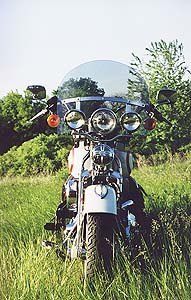
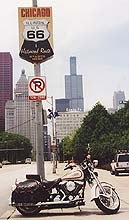
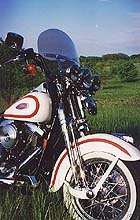
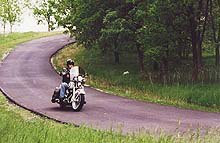
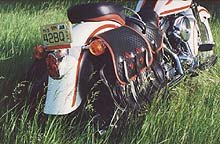
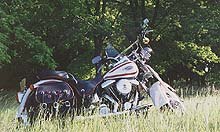

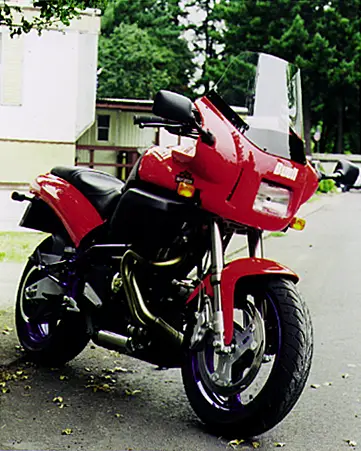
 Riding skills can mean a lot of things. For example, riding skills can
mean how fast a motorcyclist navigates a “tricky” section of road.
Imagine you reach a really twisty section of mountain highway, just what
you have been waiting to enjoy on your trip. However, the other rider
is a bit intimidated by those same roads and slows down...a lot!
Riding skills can mean a lot of things. For example, riding skills can
mean how fast a motorcyclist navigates a “tricky” section of road.
Imagine you reach a really twisty section of mountain highway, just what
you have been waiting to enjoy on your trip. However, the other rider
is a bit intimidated by those same roads and slows down...a lot!






































